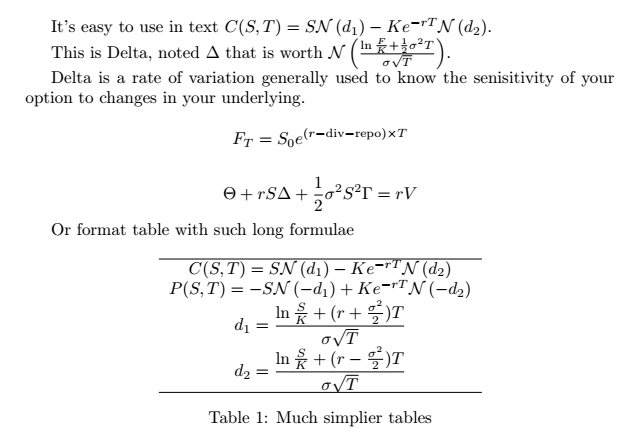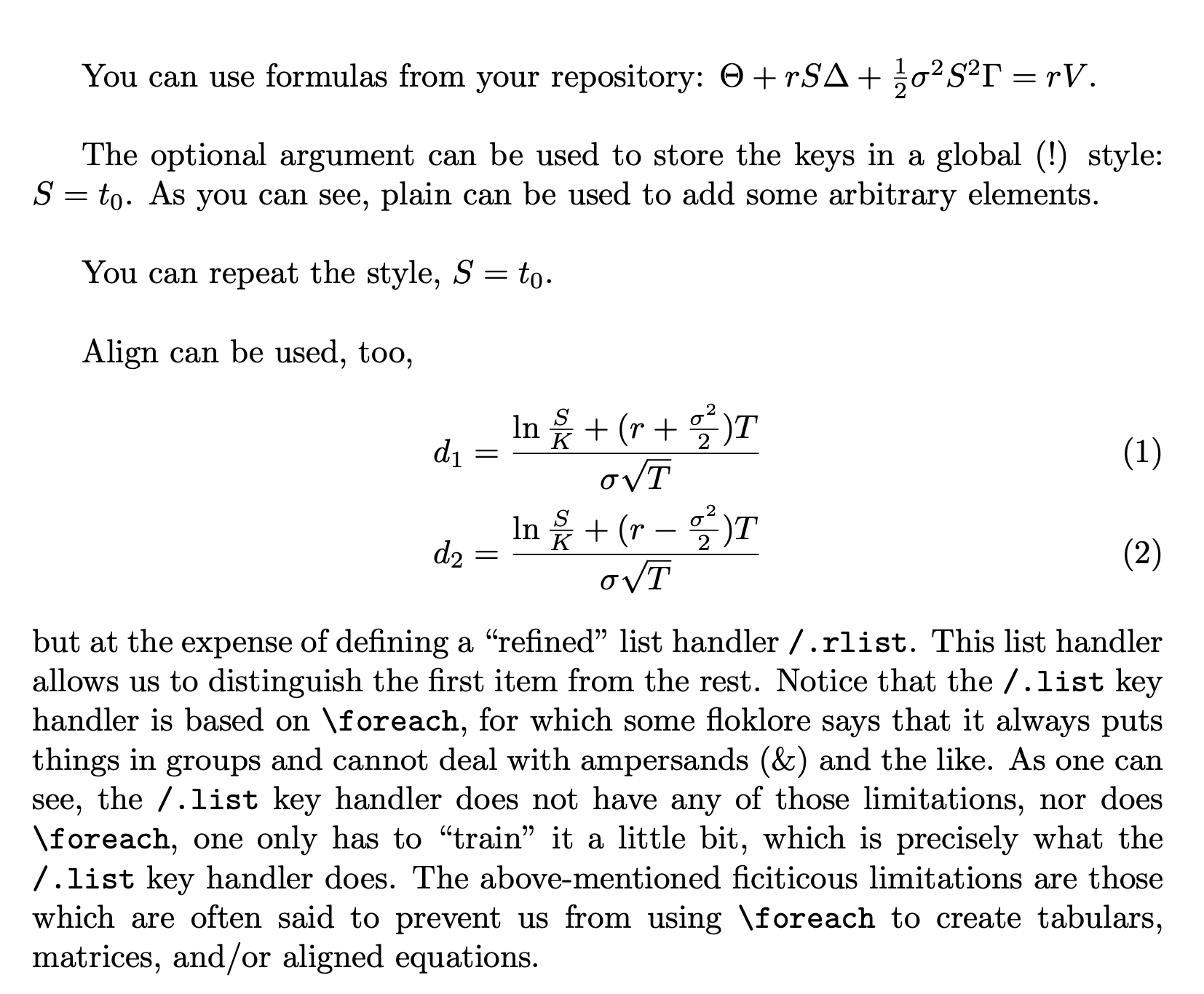JeT

**My (open) question**
How can I extend the benefits of `pgfkeys` to store and resuse formulae ?
**Context**
So many long formuale I use again and again... I saw many advantages to store my formulae in `pgfkeys`:
- It simplifies typing (e.g. `\RF[delta]`), especially when long formulae got to be in a table.
- it avoids the multiplication of `\def` (I get lost after 100 macros with weirder and longer names to remember).
- One can use numbers (e.g. `\RF[d1]`)
- One centralizes the format and thus one can check the consistency of notations.
- as a result, one avoid discrepancies in typing of the formulae between different documents.
- Could be useful for index, labelling/cross referencing, nomenclatures
- ... probably many other thing (I've not thought about yet...)
**Where do I stand ?**
So far I have a simple working (storing) solution (see MWE below).

**Where do I need insight ?**
If you had to think about the equations you keep using, How would you see a smart way to centralize information you'll need about these equations ? And reuse it efficiently.
I bascally use `/.initial` but there must be other keys to do the job better (list ?).
PS : Probably related to [this great answer](https://topanswers.xyz/tex?q=1557) since I intend to draw or calculate values for these equations at some point.
**Example of applications I have in mind**
```
\documentclass{article}
\usepackage{tikz}
\usepackage{mathtools}
% I used long formulae on purpose
\pgfkeys{
formula/.is family,
formula,
spot/.initial = { S },
today/.initial = { t_0 },
maturity/.initial = { T },
TTM/.initial = { T-t },
abm/.initial = { {S_{t}=S_{0}+\mu t+\sigma W_{t}} },
gmb/.initial = { \mu=\mathbb{E}(R_{t})=\mathbb{E}\left[\frac{dS_{t}}{S_{t}}\right] },
forward/.initial = { F =\displaystyle Se^{rt}},
forward div repo/.initial = { F_T = S_0 e^{(r-\text{div}-\text{repo})\times T} },
delta/.initial = { \mathcal{N}\left(\frac{\ln \frac{F}{K} +\frac{1}{2}\sigma^2T}{\sigma \sqrt{T}}\right) },
d1/.initial = { d_1 = \displaystyle \frac{\ln\frac{S}{K} + (r + \frac{\sigma^2}{2})T}{\sigma \sqrt{T}}},
d2/.initial = { d_2 = \displaystyle \frac{\ln\frac{S}{K} + (r - \frac{\sigma^2}{2})T}{\sigma \sqrt{T}}},
edp/.initial = { \Theta + r S \Delta + \frac{1}{2} \sigma^2 S^2 \Gamma = r V},
call/.initial = { C(S, T) = S \mathcal{N}\left( d_1 \right) - K e^{-rT} \mathcal{N}\left( d_2\right)},
put/.initial = { P(S, T) = -S \mathcal{N}\left( - d_1 \right) + K e^{-rT} \mathcal{N}\left( - d_2\right)},
}
\newcommand\formula[1]{\pgfkeys{formula,#1}}
% ReuseFormula (\RF)
\newcommand\RF[1][]{ \formula{#1} }
\begin{document}
It's easy to use in text $\RF[call]$.
This is Delta, noted $\Delta$ that is worth $ \RF[delta] $.
Delta is a rate of variation generally used to know the senisitivity of your option to changes in your underlying.
\[\RF[forward div repo] \]
\[ \RF[edp] \]
Or format table with such long formulae
\begin{table}[tph]
\centering
\begin{tabular}{c}
\hline
$\RF[call]$ \\
$\RF[put]$ \\
$\RF[d1]$ \\
$\RF[d2]$ \\
\hline
\end{tabular}
\caption{Much simplier tables}
\end{table}
\end{document}
```
Top Answer
user 3.14159

I'm not sure if any of my suggestions is useful. Yes, you can store elements of equations in pgf keys, and this can make a lot of sense because of name space limitations. You can also "learn" and repeat combinations, but this affords global styles. Unfortunately, I was unable to get satisfactory results in align environments generated by the `/.list` key handler, but if you are willing to use a "refined" list handler this works, too.
```
\documentclass{article}
\usepackage{pgffor}
\usepackage{mathtools}
\makeatletter% stolen from forest
\pgfkeys{/handlers/.global style/.code=\pgfkeys{\pgfkeyscurrentpath/.global code=\pgfkeysalso{#1}}}
\pgfkeysdef{/handlers/.global code}{\pgfkeysglobaldef{\pgfkeyscurrentpath}{#1}}
\long\def\pgfkeysglobaldef#1#2{%
\long\def\pgfkeys@temp##1\pgfeov{#2}%
\pgfkeysgloballet{#1/.@cmd}{\pgfkeys@temp}%
\pgfkeysglobalsetvalue{#1/.@body}{#2}%
}
\def\pgfkeysgloballet#1#2{%
\expandafter\global\expandafter\let\csname pgfk@#1\endcsname#2%
}
\long\def\pgfkeysglobalsetvalue#1#2{%
\pgfkeys@temptoks{#2}\expandafter\xdef\csname pgfk@#1\endcsname{\the\pgfkeys@temptoks}%
}
\makeatother
\newcommand{\diff}{\mathop{}\!\text{d}}
\DeclareMathOperator{\Euler}{e}
% I used long formulae on purpose
\pgfkeys{
formula/.is family,
formula/.unknown/.code={#1},
formula/.cd,
plain/.code={#1},
edp/.code = { \Theta + r S \Delta + \frac{1}{2} \sigma^2 S^2 \Gamma = r V},
spot/.code = { S },
today/.code = { t_0 },
maturity/.code = { T },
TTM/.code = { T-t },
delta/.initial = { \mathcal{N}\left(\frac{\ln \frac{F}{K} +\frac{1}{2}\sigma^2T}{\sigma \sqrt{T}}\right) },
d_1/.code = { \frac{\ln\frac{S}{K} + (r + \frac{\sigma^2}{2})T}{\sigma \sqrt{T}}},
d_2/.code = { \frac{\ln\frac{S}{K} + (r - \frac{\sigma^2}{2})T}{\sigma \sqrt{T}}},
do align/.code={\pgfkeys{formula/list/unless first=\\}%
#1&=\formula{#1}},
}
\makeatletter
\newif\if@pgf@rlist@first
\pgfkeys{
formula/.cd,
list/only first/.code={\if@pgf@rlist@first#1\fi},
list/unless first/.code={\if@pgf@rlist@first\global\@pgf@rlist@firstfalse\else#1\fi},
}
\pgfkeys{/handlers/.rlist/.code=%
{%
\ifx\foreach\@undefined%
\pgfkeys@error{You need to load the pgffor package to use the .list key syntax.}%
\fi%
\global\@pgf@rlist@firsttrue
% Use foreach to unfold the list
\def\pgf@keys@temp{}%
\foreach \pgf@keys@key in{#1}%
{\expandafter\expandafter\expandafter\gdef%
\expandafter\expandafter\expandafter\pgf@keys@temp%
\expandafter\expandafter\expandafter{\expandafter\pgf@keys@temp\expandafter{\pgf@keys@key}}}%
\edef\pgf@keys@list@path{\pgfkeyscurrentpath}%
\expandafter\expandafter\expandafter\pgf@keys@do@list%
\expandafter\expandafter\expandafter{\expandafter\pgf@keys@list@path\expandafter}\pgf@keys@temp\pgf@stop%
}%
}
\makeatother
\newcommand\formula[2][]{%
\ifx#1\relax\relax
\else
\pgfkeys{formula/.cd,@#1/.global style={#2}}%
\fi
\pgfkeys{formula/.cd,#2}}
\newcommand\RF[2][]{\formula{@#2}}
\begin{document}
You can use formulas from your repository:
$\formula{edp}$.\bigskip
The optional argument can be used to store the keys in a global (!) style:
$\formula[f1]{spot,plain={=},today}$. As you can see, plain can be used to add
some arbitrary elements.\bigskip
You can repeat the style, $\RF{f1}$.\bigskip
Align can be used, too,
\begin{align}
\pgfkeys{formula/do align/.rlist={d_1,d_2}}
\end{align}
but at the expense of defining a ``refined'' list handler \texttt{/.rlist}. This
list handler allows us to distinguish the first item from the rest. Notice that
the \texttt{/.list} key handler is based on \verb|\foreach|, for which some
folklore says that it always puts things in groups and cannot deal with ampersands
($\&$) and the like. As one can see, the \texttt{/.list} key handler does not
have any of those limitations, nor does \verb|\foreach|, one only has to
``train'' it a little bit, which is precisely what the \texttt{/.list} key
handler does. The above-mentioned ficiticous limitations are those which are
often said to prevent us from using \verb|\foreach| to create tabulars,
matrices, and/or aligned equations.
\end{document}
```
